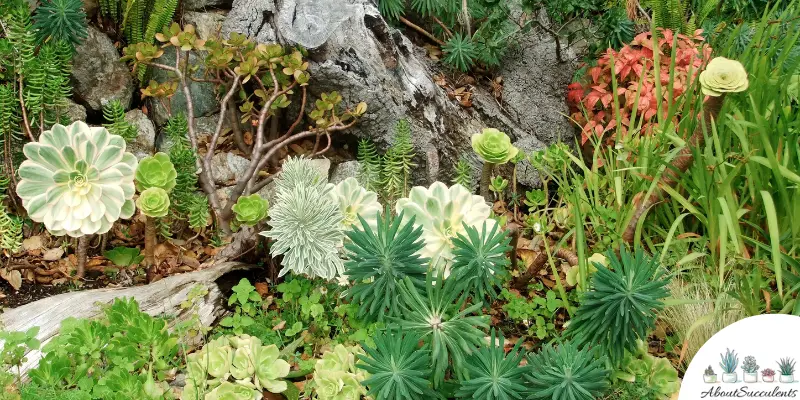
If you found yourself transfixed on a small but charming Kalanchoe thyrsiflora while walking along the massive corridors of a 5-star hotel, you’re not alone. Succulent plants are known to do that – capture the attention of onlookers. While captivating indoors, succulents can also be grown outdoors.
As outdoor plants, succulents are often used as a groundcover because of their durability especially for sloping areas that present challenges for landscape artists.
Succulent plants can also be used as patio accents or grouped in combinations of colors, shapes, flowers, foliage, and features to come up with an eye-catching succulent garden.
In some cases, a landscape artist may use succulents not only for its aesthetic beauty but to perform functions as a brush fire defense or as a living fence.
Which Succulents Can You Plant Outdoors?
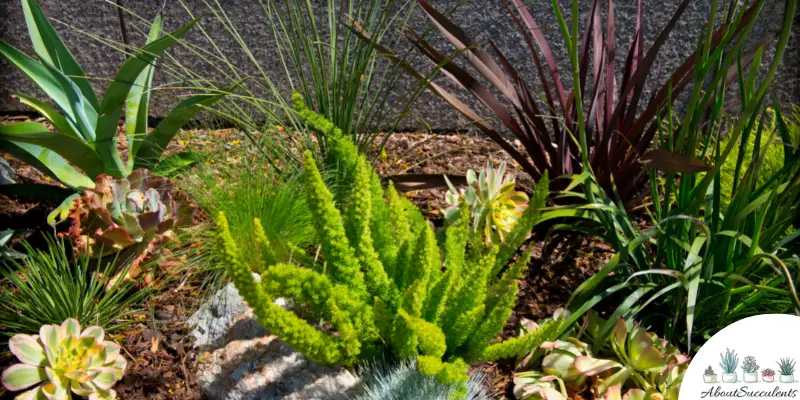
One of the most interesting features of a succulent plant is that it can store large amounts of water in its leaves. This allows the plant to survive long periods without water.
There are varieties of succulent plants that are more drought-tolerant than others. For example, echeverias originate from Mexico and are best suited for hotter and dryer climates. However, echeverias cannot tolerate freezing temperatures.
If your area experiences temperature drops below 30° F (-1.1° C), it would be best to plant more frost-tolerant succulent plants particularly those from the genus Sempervivums and Stonecrop sedums.
Both of these types of succulent plants can survive temperatures that can drop below -20° F (-28° C)
Succulents can be planted on the ground or inside a container. If you live in a region where temperatures fall to freezing levels, it would be advisable to plant the succulent inside a container that can be moved indoors.
How To Care For Succulents Outdoors
Horticulturists and hobbyists alike love succulents because these plants are easy to care for and grow. If you enjoy landscaping, succulent plants are always a welcome addition to your garden.
Before planting succulents in your garden, take a few minutes to read our helpful tips on how to take care of these magnificent plants in the great outdoors.
What Is The Best Type Of Soil To Use?
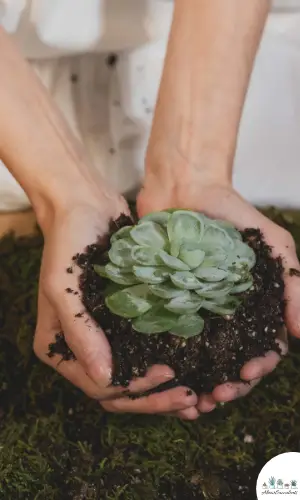
Do you live in a dry environment or one that is humid? The type of soil you use will not only help your succulent survive adverse weather conditions, but it will also thrive and live longer.
In a dry environment, the soil you use should not dry out too quickly. Your succulent needs water to extract the soil’s nutrients.
In contrast, for a humid environment, the preferred type of soil is one that dries out and keeps the roots from getting immersed in water for a long period of time. Otherwise, the roots will rot.
First, you have to figure out if you will plant the succulent in the garden or inside a pot that can be moved indoors. As we mentioned earlier, if you live in a region that experiences frost, it’s better to plant the succulent in a pot.
Choose a pot that enables air to circulate and evaporation to occur. The best material for your succulent container is terra cotta or clay. Second, make sure the pot has a drain hole for excess water to pass through.
Now, let’s talk about the soil.
You can always buy commercially-available soil that has been formulated specifically for your region. Cactus soil is fast draining and is the consensus choice for best all-around soil for succulent plants.
Manufacturers may add materials such as pine coir to improve drainage plus ingredients that prevent the growth of pathogens. In humid areas, you might want to add pumice, coarse rock, perlite, and crushed granite to further improve drainage.
You can also make your own soil mix for your succulent plants.
Whether you decide to plant the succulents in a garden or house them in terra cotta pots, we suggest baking the garden soil in an oven at 200 degrees Fahrenheit (93 degrees Celsius) for 30 minutes to destroy the pathogens.
Once the soil has cooled down, combine the following ingredients:
- 3 cups of garden soil
- 2 cups of sand
- 1.5 cups or perlite or pumice
Lightly moisten the garden soil to keep dust from coming to the surface. Next, mix in the sand. Some of you may prefer to use gloves and that is okay. But using bare hands at this stage of the process will be more effective.
Finally, add the perlite or pumice and mix it in thoroughly. For a better draining soil, use perlite and pumice.
Your home-made succulent soil is now ready for use!
How to Water a Succulent Outdoors
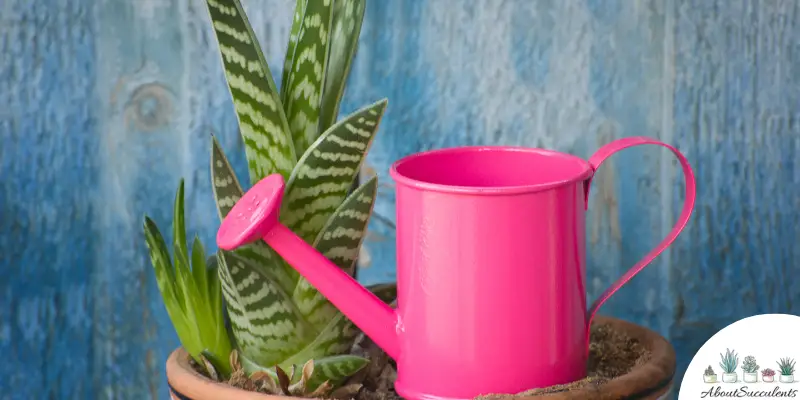
Should you water the succulent after you’ve planted it in your DIY soil?
Remember, the garden soil was lightly moistened. If the soil feels moist, do not water the succulent. Run the “stick test” and if the inserted end of the stick feels moist, put off watering until the soil is completely dry.
The single biggest cause of death for succulents is overwatering. In fact, it is better to under-water succulents than to overwater them.
Keep in mind that succulents store water in their leaves. They can last weeks without water. Succulents with fleshy, plump leaves such as the echeveria can survive a month without water.
When a plant’s roots are immersed in water, they expand. Too much water will cause its cells to burst and lead to root rotting. A succulent with rotting roots can deteriorate very quickly. Infection can spread to all of its sections and kill your succulent within a few days.
It is worth mentioning again to only give the succulent water when the soil is completely dry. If you want to be sure, use a hygrometer which measures the level of moisture in the air.
Succulents absorb water through the air around them.
When you are 100% confident that the soil has dried out completely, give it a thorough soaking! If the succulent is in a pot, once you see water leaking out of the drainage hole and onto the tray, the soil has been properly drenched.
Very important: Do not water the succulent from above. Always water directly on the soil. If the leaves get wet, then it will take longer for the succulent to dry out. The best container to use to water the succulent is one that has a gooseneck.
Water the succulents during the early morning or early afternoon and never late at night because it will take the soil longer to dry out.
In the wintertime, the soil will remain moist for a longer period of time. Therefore, succulents will require fewer watering sessions.
To make a comparison, if it normally takes 7 to 10 days between watering sessions during the spring and summer seasons, it may take up to 20 days in the winter.
How Much Sunlight Does a Succulent Need?
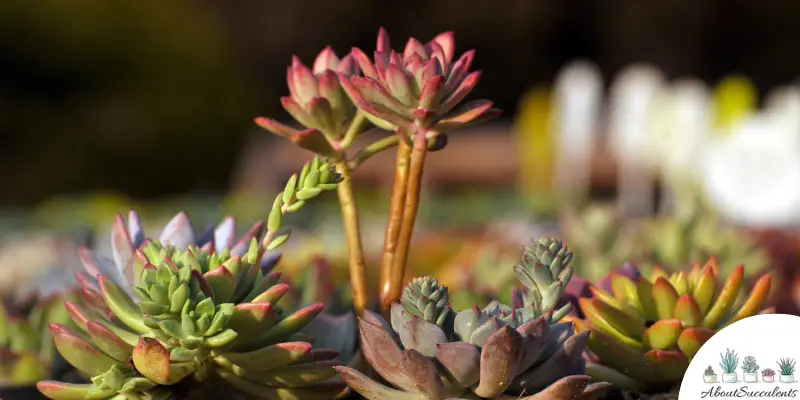
Succulents need sunlight to convert the nutrients that were extracted from the soil into food. Sunlight also allows bright-colored succulent plants such as Campfire Plant, Lipstick, and Dessert Cabbage to bring out their full beauty.
If your succulent is not getting enough sunlight, its leaves will stretch out as if they were reaching up to the sky. This condition is called etiolation which results in weakened plants that look pale because of lack of chlorophyll.
However, too much sun exposure can damage your succulent. These plants store water in the stems and leaves. If kept under the scorching heat of the sun for long hours, your succulent can get scarred or sunburned.
For bright-colored succulent plants, excessive sunlight can tarnish their vibrant look and instead give them a washed-out appearance.
Outdoor succulents are best planted in an area in the garden that gets 3 to 6 hours of sunlight. Avoid areas that get exposed to mid-afternoon sunlight for extended hours.
Do Outdoor Succulents Need Fertilizer?
While succulents derive nourishment from the soil, watering can flush out some of the nutrients. Adding fertilizer to the soil ensures that the succulent gets proper nutrition to keep it healthy and strong.
The best time to give your succulent fertilizer is the springtime which is growing season. You only need to fertilize the soil once during springtime and again in late summer or early fall to get wonderful results.
The important thing to remember when fertilizing succulents is to reduce its level of strength before adding it to the soil. Otherwise, the succulent can get burned.
As an example, if you are using an 8-8-8 or 10-10-10 (NPK or Nitrogen- Phosphorous – Potassium) formula that recommends one tablespoon of fertilizer per one gallon of water, use only ½ or ¼ of the recommended amount.
For your choice of fertilizer, it should be:
- Organic
- Low NPK – Especially, nitrogen
- Has probiotics and other soil microbes such as mychorrhizae
- Contain humic acids
- A slow-release blend
Do not apply the fertilizer if the topsoil is still moist. Just like a typical watering session, the soil must be completely dry before adding fertilizer.
How To Protect Your Outdoor Succulent From Pests
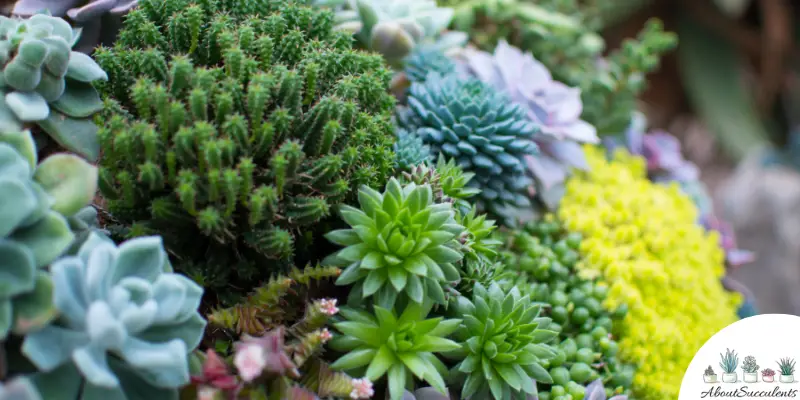
Succulents are very durable plants but that does not mean their health can be affected by pests. Among the common pests that infest succulent plants include:
- Mealybugs
- Aphids
- Spider Mites
- Fungus Gnats
- Scale
- Whiteflies
- Ants
These pests can harm your succulent plant by drinking its sap. Mealybugs and aphids secrete a sugary substance that can promote the growth of molds on your succulent.
Here are a few helpful tips on how to protect your succulents from these pests:
- Dip a Q-Tip in denatured alcohol to remove the white, cotton-like substance left by mealybugs on the leaves.
- Spray the succulent with neem oil once-a-week until the pests are gone. Spray only at night because the sun’s rays might cause the neem oil to heat up and burn the succulent.
- Remove all dead leaves that have accumulated near the succulent. Mealybugs and other pests tend to nestle under dead leaves.
- If Fungus Gnats have invaded your succulent, sprinkle a bit of cinnamon on the soil. Cinnamon can help prevent a bacterial infection from spreading.
Pesticides and insecticides should be your last resort because they can kill the insects that are beneficial for your succulent plant’s growth.
One such insect is the ladybug. You can buy ladybugs from any gardening store and unleash them in your garden. Ladybugs are natural predators that love feasting on these pests.
Conclusion
Succulent plants are everything you want for your garden. They are beautiful, durable, highly tolerant to changes in weather conditions, and are easy to grow, care for, and propagate.
Having succulents will add life and color to your garden and draw admiration from your neighbors for your landscaping skills!
Like all the good things in life, you have to give succulents proper care and attention. And it’s not difficult at all. Give the succulents enough sunlight and water the soil whenever it has dried out completely.
A little bit of tender loving care will go a long way in helping you grow beautiful, eye-catching succulent plants that will stay with you and keep your garden amazing-looking for several years.
Last Updated on June 27, 2022 by Sofia Lara